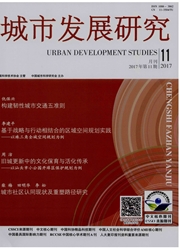

 中文摘要:
中文摘要:
尝试构建一个城市群演化视角下特大城市产业优化发展的理论分析框架,即环境、效率与均衡三维协同的3E发展约束模型(3E模型),用以分析特大城市产业优化发展所需,同时兼顾考虑环境约束、效率约束及均衡约束。以长三角城市群的上海、京津冀城市群的北京和成渝城市群的重庆3个特大城市为对象进行实证考察。研究发现:一,当前我国特大城市产业发展面临环境、效率和均衡方面的严峻挑战,在水资源、能源利用效率方面仍处于较低水平,综合劳动效率和各产业的劳动效率等仍都有较大的提升空间,就业—居住均衡偏离较大,产业亟待优化推进;二,特大城市产业优化要协同考虑城市面临的环境约束、效率约束和均衡约束,推动水资源、能源等的消耗水平大、产业劳动效率低且职住均衡较难实现的产业退出城市群的中心城市,形成特大城市产业发展的门槛约束;三,不同发展阶段城市群的核心城市应采取差别化的产业优化调整政策,分别采取一体化导向下实施产业功能提升策略、功能疏解导向下的区域协同策略和极化发展导向下的聚焦重点产业升级战略,推动不同阶段特大城市产业的优化发展。
 英文摘要:
英文摘要:
This paper is trying to build a theoretical analysis structure for the industry optimization in China’s mega cities —— that is the synergy among Environment,Efficiency,and Equilibrium,a 3E model. This model,subject to the environment constraint,efficiency constraint,and equilibrium constraint,is used to analyze industry optimization in mega cities. We apply the data of Shanghai from Yangtze River Delta,data of Beijing from Jing-Jin-Ji region,and data of Chongqing from Chengyu urban agglomeration. The conclusions are: first,both water and energy utilization efficiency of industries are at low levels; comprehensive labor efficiency and industrial labor efficiency still have room for improvement,and there is a huge deviation for employment-living equilibrium. Secondly,it is necessary to take account of environment,efficiency,and equilibrium constraints for industrial development,and to make those industries with large input of water and energy,low labor efficiency,non-equilibrium of employment-living leave central cities. In this way,the threshold of industrial development in mega cities is being building up. The specific industry policies for these three mega cities are: under the background of integration of Yangtze River Delta,to carry out the policies on improvement of industrial functions in Shanghai; for Beijing in Jing-Jin-Ji,to synergize regions under the guide of function dispersal; for Chongqing in Chengyu urban agglomeration,to concentrate on major industries upgrading oriented by the strategy of polarization.
 同期刊论文项目
同期刊论文项目
 同项目期刊论文
同项目期刊论文
 期刊信息
期刊信息
